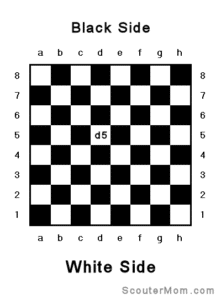I always go over terminology first when introducing something new to Scouts. This is a good practice for Scouts BSA and Venturers to learn also whenever they are doing skill instruction. So if you are having a chess themed meeting or activity, make sure you are all speaking the same language first by reviewing chess terminology. These are some very basic definitions to get you started.
These simple definitions are meant for introducing the subject of chess. If you are really into chess or you want to learn more details about chess terminology, you will enjoy the World Chess Federation site.
Chess Terminology: The Pieces
- The King: The king is the most important piece. The object of the game is to capture the opponents King. The King can move one square in any direction. The King may never move into check. Each player starts with one king.
- The Queen: The Queen is the most powerful piece. She can move any number of squares in any direction if her path is not blocked. Each player starts with one queen.
- The Rook: The Rook can move any number of squares vertically or horizontally if its path is not blocked. Each player starts with two rooks, one on each end of the row at the end of the board.
- The Bishop: The Bishop can move any number of squares diagonally if its path is not blocked. Each player starts with two bishops, one on each side of the King and Queen.
- The Knight: The Knight’s move is special, as it can jump over other pieces. It moves two squares horizontally or vertically and then makes a right-angle turn for one more square. The Knight always lands on a square opposite in color from the color of the square it left. Each player starts with two knights, between the bishops and the rooks.
- The Pawn: The Pawn moves straight ahead (never backward), but it captures diagonally. It moves one square at a time, except on its first move, when it has the option of moving forward one or two squares. Each player starts with eight pawns.
Chess Terminology: The Outcomes
- Check: Check is when the King is in a position such that he is threatened with capture.
- Checkmate: Checkmate is when the King is in check and there is no way to escape.
- Stalemate: A position in which the player whose turn it is to move has no legal move and his king is not in check. A stalemate results in an immediate draw. The game ends without victory for either player.
- Resign: To concede loss of the game. The traditional way to resign is by tipping over one’s king.
Chess Terminology: Board Notation

For older Scouts, you can go into some of the more complicated chess terminology, such as board notation and special moves:
Algebraic Chess Notation: The columns (called files) are labeled by the letters a to h from left to right from the white player’s point of view, and the rows (called ranks) by the numbers 1 to 8, with 1 being closest to the white player. (See diagram)
Board notation is important when recording the moves in a game on score sheets.
Chess Terminology: Special Moves
- Castle: The king moves two squares toward one of its rooks and then the rook is placed on the other side of the king. Castling consists of moving the king two squares on its first rank toward either one of the original rooks, then moving the rook onto the square over which the king crossed. Castling is allowed only when neither the king nor the castling rook has previously moved, when no squares between them are occupied, when the king is not in check, and when the king will not move across or end its movement on a square that is under enemy control.
- En Passant: This is a special pawn capture which can occur immediately after a player moves a pawn two squares forward from its starting position, and an opposing pawn could have captured it, had it moved only one square forward. The opponent captures the just-moved pawn as if taking it “as it passes” through the first square. The resulting position is the same as if the pawn had moved only one square forward and the opposing pawn had captured normally. The en passant capture must be done on the very next turn, or the right to do so is lost. This is the only move in chess in which a piece does not move to the space of the piece it captured.
- Promotion: When a pawn advances to his opponent’s side of the board, as a part of the move it is promoted and must be exchanged for the player’s choice of queen, rook, bishop, or knight of the same color. Usually, the pawn is chosen to be promoted to a queen, but in some cases another piece is chosen; this is called underpromotion.There is no restriction placed on the piece that is chosen on promotion, so it is possible to have more pieces of the same type than at the start of the game (for example, two queens).
Related Resources for Chess Terminology
Use this chess terminology with these Scouting ideas:

Chess Merit Badge
Chess terminology is part of the Chess Merit Badge. Scouts develop their critical thinking and strategy skills while doing the requirements for the this merit badge. They learn the history of chess, and chess notation. Scouts familiarize themselves with the tactics, board, pieces, and moves. Then they demonstrate their skills by playing some games of chess.

Leave a Reply